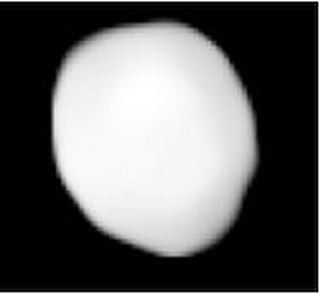
Europa is the 6th-largest asteroid in the asteroid belt, having a diameter of over 300 km, though it is not correspondingly massive. It is not round but is shaped like an ellipsoid of approximately 380×330×250 km. It was discovered on 4 February 1858, by Hermann Goldschmidt from his balcony in Paris. It is named after Europa, one of Zeus's conquests in Greek mythology, a name it shares with Jupiter's moon Europa.

Pomona is a stony main-belt asteroid that is 81 kilometres (50 mi) in diameter. It was discovered by German-French astronomer Hermann Mayer Salomon Goldschmidt on October 26, 1854, and is named after Pōmōna, the Roman goddess of fruit trees.

Hekate is a large main-belt asteroid.

Lydia is a large belt asteroid with an M-type spectrum, and thus may be metallic in composition, consisting primarily of nickel-iron. It was discovered by French astronomer Alphonse Borrelly on 19 April 1870 and was named for Lydia, the Asia Minor country populated by Phrygians. The Lydia family of asteroids is named after it.
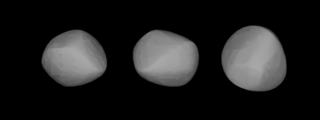
115 Thyra is a fairly large and bright inner main-belt asteroid that was discovered by Canadian-American astronomer J. C. Watson on August 6, 1871 and was named for Thyra, the consort of King Gorm the Old of Denmark. Based upon its spectrum, it is categorized as a stony S-type asteroid.
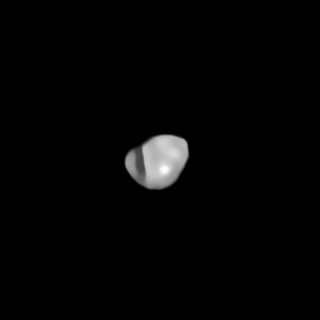
Lamberta is a main-belt asteroid that was discovered by Corsican-born French astronomer Jérôme Eugène Coggia on April 11, 1878, and named after the astronomer Johann Heinrich Lambert. It was the second of Coggia's five asteroid discoveries.

Ampella is a Main belt asteroid that was discovered by Alphonse Borrelly on June 13, 1879. The name seems to be the feminine form of Ampelos, a satyr and good friend of Dionysus in Greek mythology. It could also derive from the Ampelose, a variety of hamadryad. It is an S-type asteroid.

Penelope is a large main belt asteroid that was discovered by Austrian astronomer Johann Palisa on August 7, 1879, in Pola. The asteroid is named after Penelope, the wife of Odysseus in Homer's The Odyssey. It is orbiting the Sun at a distance of 2.68 AU with an eccentricity (ovalness) of 0.18 and a period of 4.381 years. The orbital plane is tilted at an angle of 5.8° to the plane of the ecliptic.

Bianca is a sizeable Main belt asteroid. It is an S-type asteroid. It was discovered by Johann Palisa on 4 September 1880, in Pola and was named after the Austro-Hungarian opera singer Bianca Bianchi. The Vienna newspapers contained several published accounts of the circumstances surrounding the honor extended to the diva in Spring 1882. In the late 1990s, a network of astronomers worldwide gathered lightcurve data that was ultimately used to derive the spin states and shape models of ten new asteroids, including (218) Bianca. The shape model for this asteroid is asymmetrical.

Libussa is a Main belt asteroid that was discovered by C. H. F. Peters on December 22, 1886, in Clinton, New York and was named after Libussa, the legendary founder of Prague. It is classified as an S-type asteroid.

Elvira is a typical main belt asteroid and is a member of the Koronis asteroid family. It was discovered by Auguste Charlois on 3 May 1888 in Nice. (277) Elvira is possibly named for a character in Alphonse de Lamartine's Méditations poétiques (1820) and Harmonies poétiques et religieuses (1830).
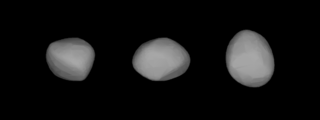
Unitas is a typical main belt asteroid that was discovered by Elia Millosevich on 1 March 1891 in Rome. The asteroid was named by the director of the Modena Observatory in honor of the Italian astronomer Angelo Secchi and the unification of Italy. It is classified as an S-type asteroid.

Huenna is a large asteroid orbiting in the asteroid belt. It is part of the Themis family, and thus a C-type asteroid and consequently composed mainly of carbonaceous material.

Ilmatar is a large Main Belt asteroid.

Siegena is a very large main-belt asteroid. It is classified as a C-type asteroid and is probably composed of primitive carbonaceous material.

Wilhelmina is a large Main belt asteroid.
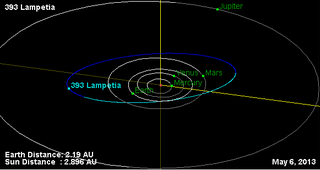
Lampetia is a fairly large main belt asteroid that was discovered by German astronomer Max Wolf on 4 November 1894 in Heidelberg. It has an unusually low rotation rate, with a period estimated at 38.7 hours and a brightness variation of 0.14 in magnitude.

Eulalia is a minor planet, specifically an asteroid orbiting in the asteroid belt. Eulalia is very near the 3:1 Jupiter orbital resonance.

694 Ekard is a minor planet orbiting the Sun that was discovered by American astronomer Joel Hastings Metcalf on November 7, 1909. The asteroid's name comes from the reverse spelling of Drake University in Des Moines, Iowa, where Seth Barnes Nicholson and his wife calculated its orbit.

720 Bohlinia is a minor planet orbiting the Sun that was discovered by Franz Kaiser, a German astronomer in 1911. It is named for Swedish astronomer Karl Petrus Theodor Bohlin, to mark his 65th birthday. He had worked on the orbits of asteroids.




















